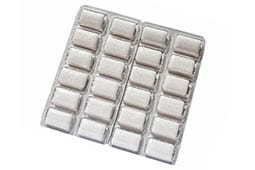How to Use Nicotine Gum
There are seven medicines approved by the Food and Drug Administration (FDA) to help you quit. They work in different ways. All have been shown to be safe and effective for adults who smoke cigarettes.
These quit-smoking medicines include nicotine replacement medicines (the nicotine patch, lozenge, gum, oral inhaler, and nasal spray) and pill medicines (varenicline and bupropion SR).
Some other strategies, with or without medicines, can help you quit as well.

Nicotine gum is not used like ordinary chewing gum. You chew it a few times and then “park” it between your cheek and the space below your teeth. The nicotine is absorbed mostly in your mouth.
Nicotine gum can be used every 1-2 hours by itself to control withdrawal symptoms, or it may be used as needed for stronger cravings when used in combination with nicotine patch.
- For best results, make sure you start on the right dose. The nicotine gum comes in two strengths (2 mg and 4 mg). The right dose for you depends on when you usually have your first cigarette each day and how much you are currently smoking. If you have your first cigarette within 30 minutes of waking, you should consider starting with the 4 mg dose. Over time (typically between 8 and 12 weeks), you can lower the dose and how often you use it until you stop using the gum completely.
- Use one piece of gum every 1-2 hours for the first 6 weeks of your quit attempt. Try to think ahead about when you might get a craving for a cigarette, and then use a piece of gum before the craving happens. To ensure that your body gets enough nicotine to ease the withdrawal symptoms you may be feeling, it is best to use at least 9 pieces of gum per day for the first 6 weeks.
- If you are using the gum along with the nicotine patch, you may not need to use the gum as frequently because you will use it when you get or expect a craving. Do not use more than 24 pieces of gum per day. Following 6 weeks of use, you can reduce use to 1 piece every 2-4 hours, and then 1 piece every 4-8 hours.
- If you use fewer than 10 cigarettes per day, or do not smoke every day, talk with your doctor or other healthcare provider about dosing. They may want you to start on a lower dose and use the gum less frequently.
- Do not eat or drink for 15 minutes before or during use. Food and drinks that are acidic, such as soda and coffee, can stop the gum from working as well.
- Nicotine gum is not like regular chewing gum. To use it correctly, bite down slowly on the gum until you feel a tingling in your mouth. Then “park” the gum between the inside of your cheek and your gums. Hold it for about a minute to let the nicotine absorb into your body. Then repeat this “chew” and “park” process until the tingling stops (usually about 30 minutes), occasionally changing where you “park” the gum in your mouth.
- Keep out of reach of children and pets. Nicotine gum may have enough nicotine to make children and pets sick. Store the gum out of reach of children and pets, and when you are done chewing a piece, wrap it in paper and immediately throw it in the trash. In case of accidental use or ingestion, contact a Poison Control Center right away (1-800-222-1222).
- Learn more about nicotine gum, including side effects and precautions.

No product endorsement implied.
- Consider combining the gum with nicotine patches. You can do this when you first start using the medicine, or if you continue to have withdrawal symptoms. Patches can provide a steady level of nicotine in the body to help lessen withdrawal, while the gum can be used to more quickly relieve cravings as they happen.
- If you have strong cravings while using the nicotine gum, make sure you are using a strong enough dose and that you are using the gum often enough. You can chew a second piece of gum within the hour if needed. If you smoke regularly, it’s best to use at least 9 pieces of gum per day for the first 6 weeks, and you can use up to 24 pieces of gum per day. You can also consider adding the nicotine patch, as described above.
- What if I slip up and smoke while using the gum? You do not need to stop using the gum if you slip up and smoke. Throw away your cigarettes and get back on track with your quit attempt. Keep using the gum as directed.
- What if I don’t like the taste of the gum? Remember that the nicotine gum is a medication, not a candy. The good news is that the gum comes in different flavors (mint, cinnamon, cherry, and other flavors). If you do not like what you start with, consider trying a different flavor.
- Will the gum stick to dentures or dental work? Nicotine gum is sugar free, but it may stick to dentures, dental caps, or partial bridges. In those cases, ask your healthcare provider or pharmacist about other quit-smoking medicines that might work better for you.
- For best results, use nicotine gum as part of a program that includes coaching support. Talk with your healthcare provider and connect with your state tobacco quitline (1-800-QUIT-NOW) for help.
- Can be used regularly and when you feel withdrawal symptoms or urges coming on.
- Acts faster than nicotine patch or quit-smoking pills.
- Can be used with the patch to deal with breakthrough urges.
- You control how often you use it so you won’t get more nicotine than you want.
- May help delay weight gain associated with quitting.
- Comes in two strengths.
- May help substitute for a cigarette because you put it in your mouth.
- Available without a prescription (over-the-counter).
- You have to remember to use it regularly and often.
- You should not eat or drink for 15 minutes before using or when it is in your mouth.
- Some people don’t like the taste or feel of nicotine gum.
- May be hard to use if you have dentures or other dental work.
- Requires learning how to use properly to work and to avoid side effects.
- Can cause stomach upset.
Possible Side Effects (and what you can do about them):
- Mouth or jaw soreness (don’t chew it like gum – learn more about how to use).
- Stomach discomfort, hiccups, and too much saliva (do not chew, suck or swallow; try lower dose or wait longer between doses).
- Light-headedness, nausea/vomiting, throat and mouth irritation from getting too much nicotine too fast (review use instructions – don’t chew like gum).
Nicotine Gum Precautions (If any of these apply to you, talk to your doctor or other healthcare provider before starting to use gum.):
- A heart attack in the last two weeks.
- A serious heart rhythm problem.
- Pain in your heart (angina) that is serious or getting worse.
- TMJ disease (bad pain in your jaw especially when eating).
- Could be pregnant or are breastfeeding.
- Less than 18 years old.
More precautions and general information are available about nicotine gum.